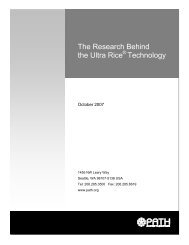Nepal Clean Home Delivery Kit: Evaluation of the Health Impact - Path
Nepal Clean Home Delivery Kit: Evaluation of the Health Impact - Path
Nepal Clean Home Delivery Kit: Evaluation of the Health Impact - Path
Create successful ePaper yourself
Turn your PDF publications into a flip-book with our unique Google optimized e-Paper software.
washing (<strong>the</strong>y had <strong>the</strong> highest proportion <strong>of</strong> hand washing and were <strong>the</strong> most likely to use<br />
soap), and it was true for kit users and non-users alike.<br />
Access and Acceptability<br />
The low level <strong>of</strong> awareness <strong>of</strong> <strong>the</strong> kit, especially in Siraha, points up <strong>the</strong> need for greater<br />
publicity about it. In Morang and Sunsari, <strong>the</strong> publicity should address <strong>the</strong> issue <strong>of</strong> where<br />
to get <strong>the</strong> kit. <strong>Health</strong> workers were an important source <strong>of</strong> information about <strong>the</strong> kit, but<br />
radio seems to have contributed to <strong>the</strong> higher levels <strong>of</strong> awareness in Morang and Sunsari.<br />
Trained TBAs represent an important distribution channel (especially in Morang and<br />
Sunsari) which should be relatively easy to streng<strong>the</strong>n. FCHVs and health posts also <strong>of</strong>fer<br />
good opportunities; inquiries in o<strong>the</strong>r regions will be needed to see if this pattern is<br />
typical elsewhere. If it is, it could guide MCH Products Pvt., Ltd. as to where it should<br />
put its marketing and distribution efforts.<br />
The high level <strong>of</strong> satisfaction with <strong>the</strong> kit and <strong>the</strong> nearly universal intention to buy again<br />
are encouraging. The perception <strong>of</strong> <strong>the</strong> kit as easy, safe, and healthy suggests <strong>the</strong>mes for<br />
future marketing and indicates that <strong>the</strong>se are features valued by consumers. The price<br />
seems to be reasonably pegged, except in Siraha, where prices were indeed much higher<br />
than <strong>the</strong> recommended price. Since <strong>the</strong> wholesale price is less than<br />
Rs. 20, <strong>the</strong> fact that about 75% <strong>of</strong> kits in Siraha were sold for at least Rs.20 (while only<br />
30% were in Morang and Sunsari) suggests that <strong>the</strong>re should be room for price<br />
competition in Siraha. The sensitivity to even slightly higher prices also suggests that any<br />
additions to <strong>the</strong> kit (and <strong>the</strong>refore <strong>the</strong> cost) should be undertaken only if <strong>the</strong>re is good<br />
evidence to support <strong>the</strong> utility and acceptability <strong>of</strong> <strong>the</strong> items.<br />
The issue <strong>of</strong> <strong>the</strong> timing <strong>of</strong> kit purchase needs fur<strong>the</strong>r study, since it was <strong>the</strong> main reason<br />
given in all three districts for not having bought a kit. It is probably related to cultural<br />
issues, such as “tempting fate” by taking direct action related to <strong>the</strong> delivery.<br />
Strengths and Limitations <strong>of</strong> <strong>the</strong> Study<br />
The unexpectedly high number <strong>of</strong> kit non-users who used a new or boiled blade greatly<br />
reduced <strong>the</strong> power <strong>of</strong> <strong>the</strong> study to detect a statistically significant difference in infection.<br />
Despite this, a tw<strong>of</strong>old increase in infection risk associated with use <strong>of</strong> a boiled (ra<strong>the</strong>r<br />
than new) blade and unclean cutting surface or <strong>of</strong> any cutting instrument o<strong>the</strong>r than a new<br />
or boiled blade was statistically significant. The strong correlation between all items in<br />
<strong>the</strong> kit made it difficult to evaluate <strong>the</strong> individual components <strong>of</strong> <strong>the</strong> kit, such as <strong>the</strong><br />
plastic tarp or <strong>the</strong> cord ties.<br />
The unexpected and unexplained rise in infection rates in <strong>the</strong> later months <strong>of</strong> <strong>the</strong> study,<br />
along with <strong>the</strong> maldistribution <strong>of</strong> cohort enrollment over time, severely confounded <strong>the</strong><br />
study, making <strong>the</strong> crude infection rates for <strong>the</strong> cohorts nearly meaningless for direct<br />
comparison. Although it is not clear why <strong>the</strong> infection rates for all cohorts were higher in<br />
<strong>the</strong> later months, it was suggested by several <strong>of</strong> <strong>the</strong> field interviewers that it might have<br />
<strong>Nepal</strong> <strong>Delivery</strong> <strong>Kit</strong> <strong>Evaluation</strong> May 2000 30
















